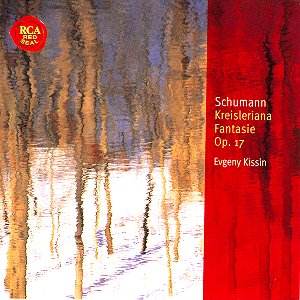These performances
of Kreisleriana and the Fantasy in C
were originally issued a few years ago
on different discs. Now they are joined
reflecting Evgeny Kissinís realization
of two of Robert Schumannís greatest
works for solo piano.
Kissin, once a child
prodigy, now has a huge reputation built
on his charismatic stage presence, virtuosity,
pianism of the highest order and exceptional
marketing strategies. Any lingering
doubts about his artistry revolve around
the degree to which he immerses himself
in a composerís soundworld/psychology.
These doubts sometimes surface here.
The basic problem is
the level of intensity and impetuosity
Kissin brings to the music. He is a
wonderful pianist, but he doesnít express
the essence of Schumannís soundworld
as consistently as the best Schumann
pianists including Annie Fischer, Earl
Wild, Walter Gieseking, Sviatoslav Richter
and Martha Argerich.
These are some examples
from the disc of Kissinís high and low
points:
Kreisleriana Ė In the
1st Movement, Schumann begins
with a highly agitated primary subject
of power, speed and wild desperation
based on ascending triplets. In the
interlude, Eusebius takes the upper-voice
melody while Florestan churns out the
energy from the lower voices; it is
Florestan and Eusebius set against one
another constituting the emotional foundation
of the interlude.
Kissinís primary subject
is quite powerful, but inexplicably
he has a few moments of inordinately
reduced tension. His interlude is very
disappointing, because the upper-voice
melody line is not particularly lilting
and actually is less poetic than the
lower voices which churn only lightly
in Kissinís hands. The effect is a complete
loss of contrast resulting in an amicable
interlude.
The 2nd
Movement is the heart of the work and
has two interludes. The first is sharp
and playful, the second super-charged
and frenzied. Kissin is attractively
exuberant in the first interlude but
does not offer sufficient tension in
the second interlude progressing up
to the tremendous climax. However, all
goes very well in the stunning primary
subject as Kissinís poignancy is at
peak level.
The hard driving 7th
Movement finds Kissin at his best. Here,
his tension is razor-sharp with a virtuosity
rarely encountered. Also, Kissinís dynamic
fugue section is the most thrilling
I have ever heard. In the 8th
Movement, the broken figures in the
primary subject are appropriately mysterious
and jittery, and the two interludes
are finely etched and dramatic.
Fantasy in C Ė Kissin
is not as successful here as in Kreisleriana.
He doesnít project significant rapture
in the 1st Movement, and
his 2nd Movement march is
a little sluggish. I have no complaints
at all with Kissinís performance of
the gorgeous 3rd Movement
that is essentially a love song to Clara
Wieck. Kissin pours out Schumannís ardor
for the young lady and does so beautifully
and with lilting inflections.
The recorded sound
has excellent clarity and depth, offering
Kissin a vivid soundstage. Piano tone
can be abrasive at times, but a decrease
in the treble controls minimizes the
effect.
In summary, Kissin
displays superb pianism and often captures
the full beauty of Schumannís music.
It is in the area of contrasting emotions
highlighted by the Florestan and Eusebius
figures where he falls from the heights
established by the greatest Schumann
interpreters. Enthusiastic supporters
of Kissin will certainly want to have
the recording, but others are advised
to sample first. Readers hoping for
a wonderful disc coupling the Fantasy
in C and Kreisleriana need look no further
than the Annie Fischer recording. I
reviewed that BBC disc which also includes
Kinderszenen, in these pages. The Fischer
is one of the best Schumann piano discs
on the market and easily surpasses the
Kissin entry.
For those who might
be a little adventurous, I highly recommend
the two Schumann recordings of Burkard
Schliessmann on the Bayer label. One
disc has the Symphonic Etudes and Kreisleriana,
while the other contains the Fantasy
in C and Lisztís Piano Sonata. Of todayís
pianists recording Schumann, Schliessmann
is the most distinctive as well as being
reminiscent of the great pianists of
the early 20th century. His
blend of musical instinct and intellectualism
is a joy to experience.
Don Satz


